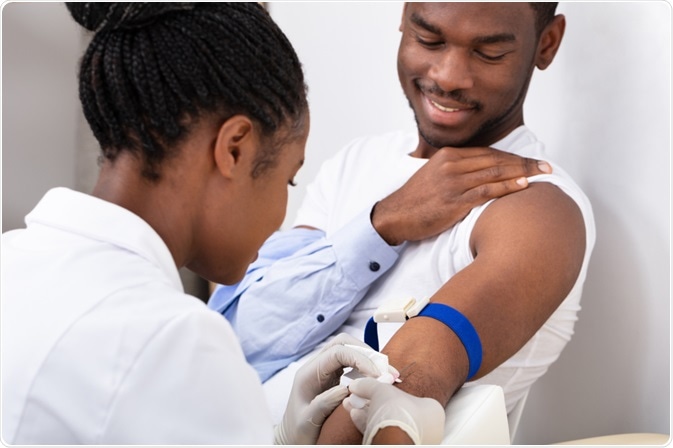Donating blood and blood products saves lives by providing essential support to emergency medicine and people with long-term conditions. It is estimated that across the United States, approximately 36,000 units of red blood cells are required daily.
In 2011 alone, almost 21 million blood products were transfused. Whilst the demand for blood components steadily increases, recruitment of new blood donors is growing increasingly difficult.

Blood Donation. Image Credit: Andrey_Popov/Shutterstock.com
The demand for blood donation
Blood donations are used to treat multiple medical conditions. Usually separated into the component parts of red blood cells, plasma, and platelets, this maximizes each blood donation as each component can be used to treat a different patient.
Donated blood products are given to patients via transfusion, whereby blood delivered into a blood vessel using an intravenous line. Approximately two-thirds of blood donations are used to treat medical conditions such as cancer, anemia, and blood disorders. The remaining third is used during surgery and emergencies. Blood transfusions are also given to terminally ill patients to improve their quality of life.
As medical technologies such as surgical interventions and plasma-derived pharmaceuticals develop, the demand for blood donations has also grown. Estimates put this growth in demand at 2-3% per year. However, the available pool of people eligible to provide blood donations is declining. This has been attributed to increasingly stringent exclusion criteria on the grounds of hemovigilance (protocols to support safe blood transfusion), an aging population, and a decline in altruism.
Altruism and blood donation
Despite many individuals being able to donate blood, and numerous high-profile public health campaigns, in the Western world approximately only 5% of people eligible to donate blood do so. Relying on altruism alone is insufficient to guarantee a sustainable supply of blood. However, regulations in most developed countries preclude monetary payments to donors. This is because voluntary donors are highly unlikely to withhold information regarding their lifestyle or medical history that would render them ineligible to donate.
Paid donors, by contrast, have been shown to more often lead lifestyles that expose them to the risk of HIV or hepatitis, be undernourished, and in poor health generally. They may be reliant on donations as a means of income, placing them at risk of exploitation and reducing their motivation to be truthful during health screenings.
Research has shown that voluntary donors have significantly lower levels of transfusion-transmissible markers of infection, with the lowest rates found among regular donators. The highest rates of infection markers are found among paid donors.
Demand for different blood types
To ensure blood products are available to all who need them, blood transfusions services must maintain regular supplies of different blood types. The types of blood and the associated demand for them varies between jurisdictions, but overall certain blood types are more in demand than others. This is because blood types are categorized according to the presence and absence of different antibodies and antigens.
There are four blood groups: types A, B, AB, and O, and each group can be either rhesus (Rh) positive or negative, depending on the presence or absence of the D antigen. Patients can receive blood transfusions from donors with the same, or a compatible blood type. For example:
- Approximately one-third of blood donors have O-positive blood, but anyone with an Rh-positive blood type can receive 0 positive red blood cells: this includes people who are A positive, B positive, and AB positive in addition to those who are O positive. This comprises roughly 75% of the population.
- Around 35% of blood donors have O-negative blood. Transfusions services need to maintain a pool of 0 negative donors as anyone can receive 0 negative red blood cells. However, maintaining adequate supplies of O-negative blood is challenging as only 8% of the general population have this blood type.
It is also crucial that transfusion services maintain supplies of rare blood types that are in demand. The Ro subtype is a variation of the Rh-positive blood type, therefore donors with A positive, B positive AB positive, or O positive blood may fall into this group. Ro subtype blood is used to treat the group of hereditary blood disorders known as sickle cell.
In sickle cell disorders, red blood cells are misshapen and block small blood vessels. They also die off early leading to a constant shortage of red blood cells. It is treated via 4-6 weekly transfusions of Ro blood. Demand for this subtype is growing by 15% per year, but only 2% of donors fall into this group.
The need for diverse blood donors
It is an urgent priority for transfusion services to increase the number of people from Black, Asian, and minority ethnic backgrounds who donate blood. This is partly to support patients who require certain blood subtypes such as the Ro subtype, and partly because the prevalence of blood types, including the rarer blood types, is related to ethnicity.
For example, Black and African/Caribbean donors are ten times more likely to have B positive and the Ro subtype than White donors. Moreover, it has been well established that matching donors and recipients by phenotype, including ethnicity, greatly increases the success of successful transfusion.
References
- Lacetera, N. and Macis, M. (2008). Incentives for altruism? The case of blood donations. [online] VoxEU.org. Available at: https://voxeu.org/article/incentives-altruism-case-blood-donations.
- Hinrichs, A., Picker, S. M., Schneider, A., Lefering, R., Neugebauer, E. A., & Gathof, B. S. (2008). Effect of blood donation on well-being of blood donors. Transfusion medicine (Oxford, England), 18(1), 40–48. https://doi.org/10.1111/j.1365-3148.2007.00805.x
- MacIntyre, L. M. (2017). The Growing Need for Diverse Blood Donors. AJN, American Journal of Nursing, 117(7), 44–48. doi: 10.1097/01.NAJ.0000520945.31600.3f.
- Provan D. (1999). Better blood transfusion. BMJ (Clinical research ed.), 318(7196), 1435–1436. https://doi.org/10.1136/bmj.318.7196.1435
Further Reading
Last Updated: May 13, 2021